
Browse an alphabetical list of photographs. These historical images portray people, places, and events before, during, and after World War II and the Holocaust.
<< Previous | Displaying results 1201-1250 of 2641 for "Photo" | Next >>
Calvinist minister Gerardus Pontier and his wife, Dora Wartema, at Yad Vashem, where they were honored for hiding Jewish children in the Netherlands. Pontier and Wartema were named "Righteous Among the Nations." Jerusalem, Israel, 1968.
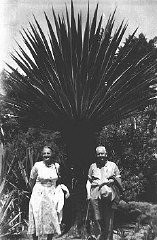
Oskar Schindler plants a tree on the Avenue of the Righteous Among the Nations at Yad Vashem. The Righteous Among the Nations are non-Jewish invididuals who have been honored by Yad Vashem, Israel's Holocaust memorial, for risking their lives to aid Jews during the Holocaust.
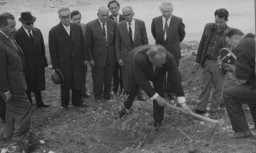
In Yad Vashem, the Israeli national institution of Holocaust commemoration, Oskar Schindler plants a tree in honor of his rescue efforts. Jerusalem, Israel, 1962.
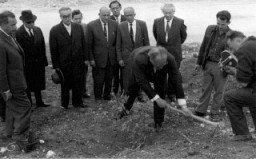
German Jews seeking to emigrate wait in the office of the Hilfsverein der Deutschen Juden (Relief Organization of German Jews). On the wall is a map of South America and a sign about emigration to Palestine. Berlin, Germany, 1935.

Horst Wessel leads his SA formation through the streets of Nuremberg during the fourth Nazi Party Congress in August 1929.
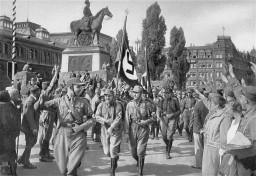
The house in Amsterdam where Tina Strobos hid over 100 Jews in a specially constructed hiding place. Her house was raided eight times, but the Jews were never discovered. Netherlands, date uncertain.
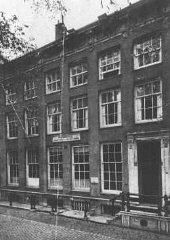
Located on Ulica Stara (Old Street), outside the Vilna ghetto, this building was used as a safe house by the ghetto resistance. Vilna, after July 1944.
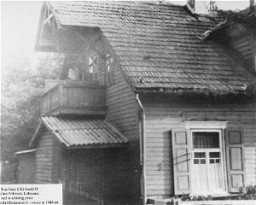
The house at Prinsengracht 263, where Anne Frank and her family were hidden. Amsterdam, the Netherlands. After 1935.

A view of the housing for Jewish displaced persons (DPs) at the Wetzlar DP camp in Germany, September 9, 1948.
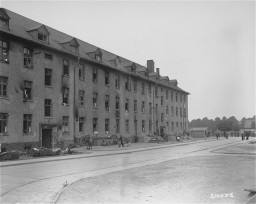
Former quarters of the German army converted into displaced persons housing. Bergen-Belsen, Germany, May 1945.

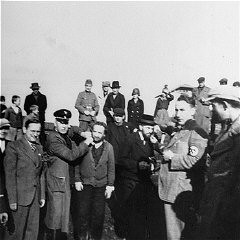
Humiliation of political prisoners: Social Democratic Party (SPD) inmates hold a placard which reads "I am a class-conscious person, party boss/SPD/party boss." Dachau concentration camp, Germany, between 1933 and 1936.

Twelve Hungarian Jewish physicians in the Iklad forced-labor camp. Iklad, Hungary, September 24, 1940.
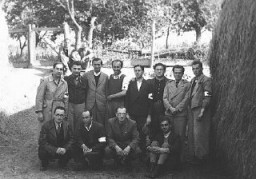
Selection of Hungarian Jews at the Auschwitz-Birkenau killing center. Poland, May 1944.
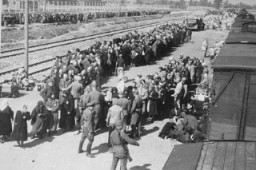
Jewish women and children from Subcarpathian Rus who have been selected for death at Auschwitz-Birkenau, walk toward the gas chambers. May 1944.
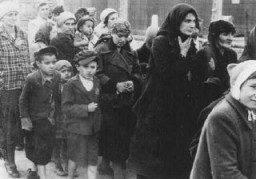
A group of Hungarian Jews rescued from deportation by Swedish diplomat Raoul Wallenberg. Budapest, Hungary, November 1944.
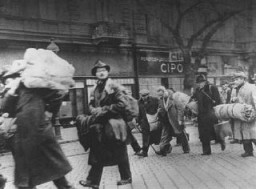
Conscripts in the Hungarian Labor Service march to a work site. Mateszalka, Hungary, September 1939.
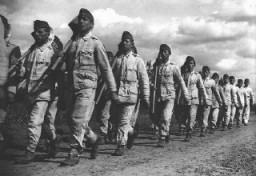
Conscripts of Hungarian Labor Service Company VIII/2 at work laying railroad track. Huszt, Hungary, 1942.
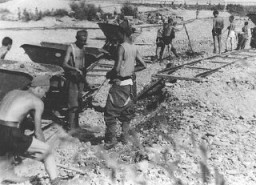
Hungarian Zionist leaders Otto Komoly and Rezso Kasztner (left), who negotiated with the SS for the release of Jews from Hungary. Budapest, Hungary, 1944.
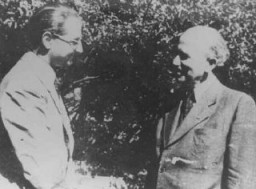
Children eating in a Warsaw ghetto street. Warsaw, Poland, between 1940 and 1943.
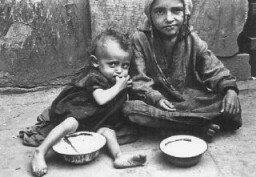
This identification card was issued to Sima Wajner, a Jewish resident of the Heidenheim displaced persons camp. The card identifies her as a former concentration camp inmate who had been imprisoned in the Stuffhof camp during the Holocaust. Card dated January 23, 1947.
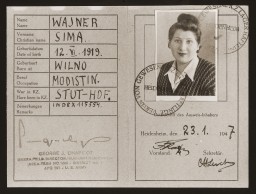
Identification card issued to Oskar Russ in the Feldafing displaced persons' camp. Oskar Russ was born in Poland in 1907. During the Holocaust, he was imprisoned in the Dachau concentration camp. After liberation, he was in the Feldafing displaced persons camp before immigrating in 1947 to the United States with his wife (whom he had married in Feldafing).
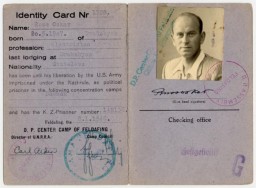
Identification card of Berthe Levy Cahen, issued by the French police in Lyon, stamped "Juif" ("Jew"). France, August 7, 1942.
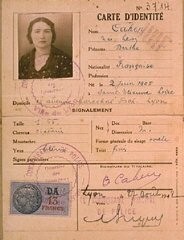
Identification pictures of a bartender from Duisburg who was arrested under Paragraph 175. Duisburg, Germany, August 27, 1936.

Identification pictures of a prisoner, accused of homosexuality, recently arrived at the Auschwitz camp. Auschwitz, Poland, between 1940 and 1945.
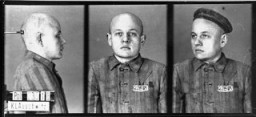
Identification pictures of a prisoner, accused of homosexuality, who arrived at the Auschwitz camp on June 6, 1941. He died there a year later. Auschwitz, Poland.
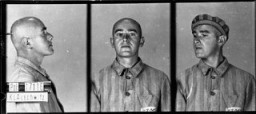
Identification picture of a prisoner, accused of homosexuality, who arrived at the Auschwitz camp on May 28, 1941. Auschwitz, Poland.
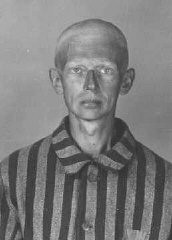
Illustrated page of a child's diary written in a Swiss refugee camp. The diary entry describes how they crossed the border into Switzerland. The text reads, "We came out of the woods and into a clearing: we had to be as quiet as possible because we were so close to the border. Oh! I almost forgot! Before we came out of the woods, they made us stand still for a quarter of an hour while they went to explore the area and to cut through the fence. Fortunately, shortly thereafter, we began to walk again. We saw…
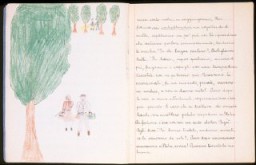
Illustration from an antisemitic children's book. The sign reads "Jews are not wanted here." Books such as this one used antisemitic caricatures in an attempt to promote Nazi racial ideology. Germany, 1936.
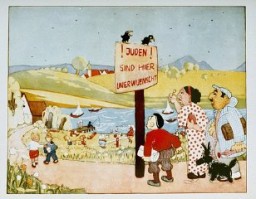
Illustration from an antisemitic German children's book, Der Giftpilz (The Poisonous Mushroom), used to indoctrinate children in the Nazi worldview. It was published in Nuremberg, Germany, in 1935. The caption to the image on the page shown here reads: "The Jewish nose is crooked, it looks like a 6."

An unidentified worker walks by the railroad tracks at the Im Fout labor camp in Morocco. Living conditions were harsh in the camp, and many of the workers fell ill with typhus. Im Fout, Morocco, 1941-42.
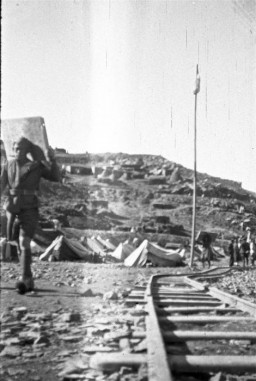
An American travel agency displays images of a peaceful Germany sent by the German Railways Information Office to attract visitors to the 1936 Olympic Games in Berlin. United States, prewar.
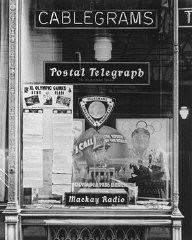
Henry Brauner (center) with his wife, Esther (second from right), pose with three friends in front of the entrance to the Stuttgart West displaced persons (DP) camp, 1945.
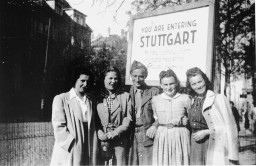
An official order incarcerating the accused in the Sachsenhausen concentration camp for the "offence" of homosexuality. Germany, July 1944. The Nazis posed as moral crusaders who wanted to stamp out what they labeled as the "vice" of homosexuality in order to help Germany win the racial struggle. They persecuted homosexuals as part of their so-called moral crusade to racially and culturally purify Germany.
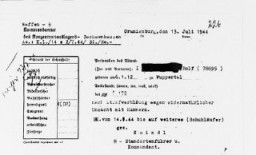
The IG Farben defendants hear the indictments against them before the start of the trial, case #6 of the Subsequent Nuremberg Proceedings. May 5, 1947.
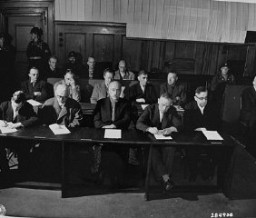
Blanka and Harry with their daughter Shelly, son-in-law, and granddaughter Alexis Danielle. San Diego, California.
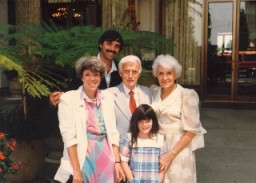
Defendant Inge Viermetz pleads not guilty at her arraignment during the RuSHA Trial, case #8 of the Subsequent Nuremberg Proceedings. October 10, 1947.
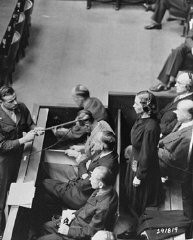
Ink and Blood by Arthur Szyk, 1944. Szyk portrayed himself at his desk, finishing off a still-struggling Adolf Hitler. Göring, Himmler, and Franco attempt to escape. In the wastebasket are the defeated figures of Mussolini, Laval, and Petain, whose regimes fell as a result of the Allied invasions. [Gift of Alexandra and Joseph Braciejowski]
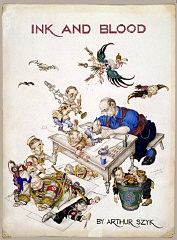
Insignia of the 101st Airborne Division. The nickname of the 101st Airborne Division, "Screaming Eagles," originates from the division's insignia, a bald eagle on a black shield. "Old Abe" was the eagle mascot of a Wisconsin regiment during the Civil War. The 101st was formed as a reserve unit in Wisconsin shortly after World War I and included "Old Abe" as part of the division's insignia.
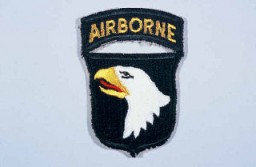
Insignia of the 103rd Infantry Division. The 103rd Infantry Division, the "Cactus" division, is so called after the 103rd's shoulder patch, a cactus in a gold circle. The cactus is representative of the states whose troops formed the unit in the early 1920s: Arizona, Colorado, and New Mexico.

Insignia of the 104th Infantry Division. The nickname of the 104th Infantry Division, "Timberwolf," originated from the division's insignia, a gray timberwolf. The timberwolf, native to the Pacific Northwest, was chosen as representative of the area where the division was formed in 1942.
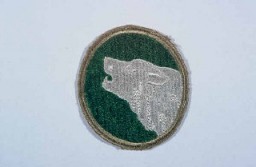
Insignia of the 10th Armored Division. The "Tiger Division" nickname of the 10th originates from a division-wide contest held while it was training in the United States, symbolizing the division "clawing and mauling" its way through the enemy.
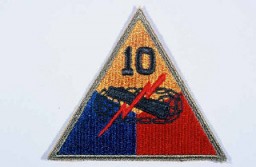
Insignia of the 11th Armored Division. "Thunderbolt" is a nickname adopted by the 11th Armored Division during its rapid march in December 1944 to reinforce US troops defending against the German military offensive in the Ardennes Forest.
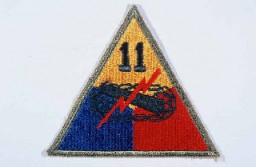
Insignia of the 12th Armored Division. "Hellcats, " the winning entry in a division contest for a nickname held in early in 1943, symbolized the 12th's toughness and readiness for combat.
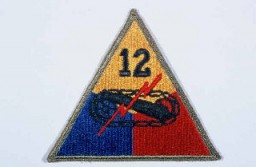
Insignia of the 14th Armored Division. Although lacking a nickname during the war, the 14th became known as the "Liberators" soon afterward to signify its accomplishments in liberating hundreds of thousands of forced and slave laborers, concentration camp prisoners, and Allied prisoners of war in 1945.
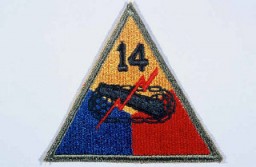
Insignia of the 1st Infantry Division. The 1st Infantry Division's nickname, the "Big Red One," originated from the division's insignia, a large red number "1" on a khaki field. This nickname was adopted during World War I, when the 1st was the first American division to arrive in France.
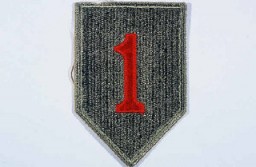
Insignia of the 20th Armored Division. Although no nickname is commonly associated with the 20th, "Armoraiders" may have been occasionally in use during World War II.
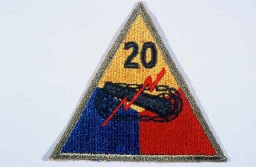
Insignia of the 26th Infantry Division. The 26th Infantry Division, the "Yankee" division, was so nicknamed to recognize the six New England states from whose National Guard units the division was raised during World War I.
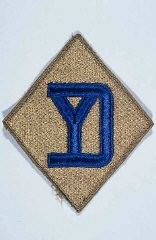
Insignia of the 29th Infantry Division. "Blue and Gray" was coined as the nickname of the 29th Infantry Division by the division's commander during World War I. The name commemorates the lineage of the mid-Atlantic states' National Guard units that formed the division, many with service on both sides during the Civil War.
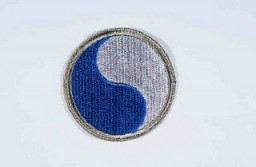
Insignia of the 2nd Infantry Division. The nickname of the 2nd Infantry Division, "Indianhead," was derived from its World War I insignia. This insignia was developed from an emblem a truck driver in the division had painted on his truck.
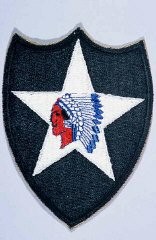
We would like to thank Crown Family Philanthropies, Abe and Ida Cooper Foundation, the Claims Conference, EVZ, and BMF for supporting the ongoing work to create content and resources for the Holocaust Encyclopedia. View the list of donor acknowledgement.